Recent Articles
Popular Makes
Body Types
2017 Nissan Armada Road Test and Review
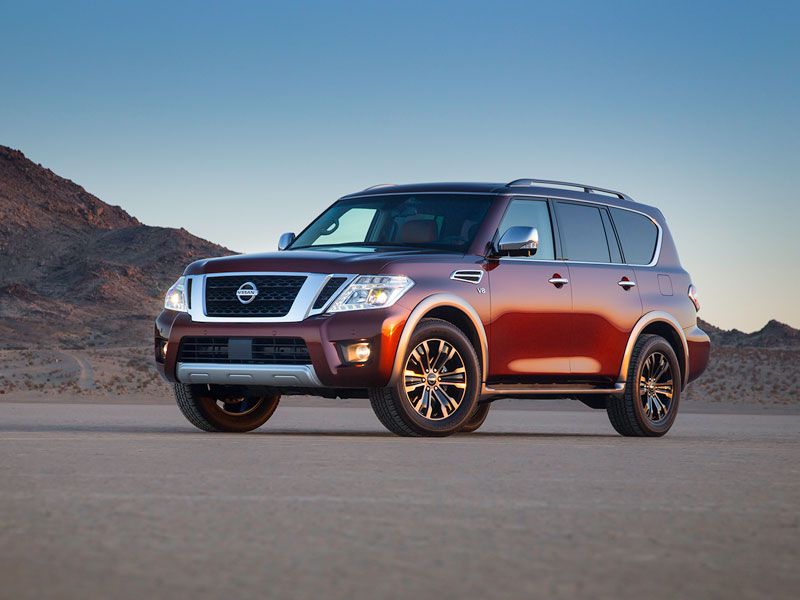
2017 Nissan Armada exterior hero brown ・ Photo by Nissan
Timing is key in nearly everything, including the car business. Nissan could not have picked a better time to introduce the new 2017 Armada: Gasoline is (relatively) cheap, the economy is improving, and Americans are spending money. In this test and review of the 2017 Armada, it's clear to us that Nissan has made some smart choices that make this fullsize SUV an appealing buy.
Nissan's Armada Sails a New Tack
Nissan introduced the first Armada back in 2004. Like the big SUVs from GM, Ford, and Toyota, the Armada was basically a fullsize pickup truck (Nissan's Titan) with a wagon body. Sales fell off when gas hit $4 per gallon, but the Armada has sold steadily since 2010—not bad for a vehicle that has remained largely unaltered for over a decade. For 2017, Nissan is changing tack. The Armada is no longer based on the Titan pickup; it's now based on the Nissan Patrol, a rugged 4x4 that has been doing battle in Europe and Asia against Toyota's legendary Land Cruiser since 1951. The change has little to do with consumer demands; Nissan is looking to free up capacity at its Mississippi truck plant, which it hopes will be needed to feed a bigger appetite for its redesigned Titan pickup. This means the Armada is no longer made in America; it will now be produced in Japan.
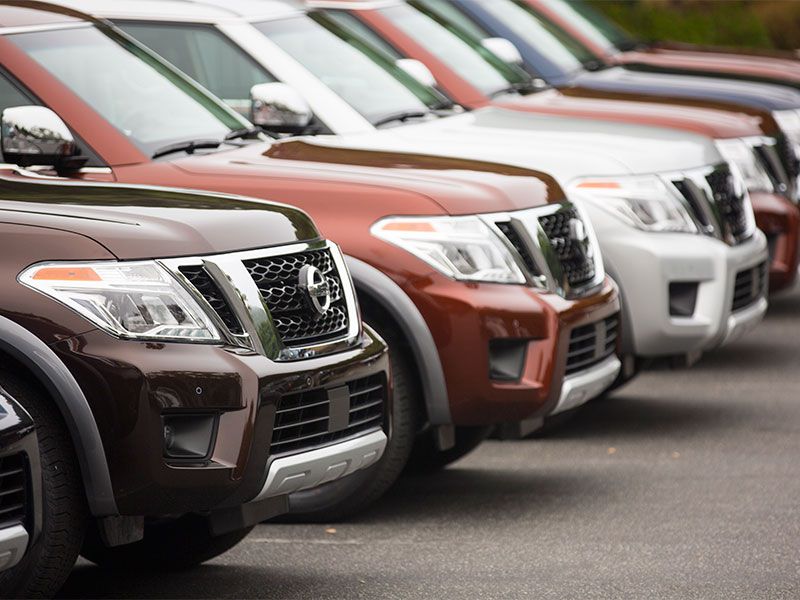
Photo by Nissan
New vs. old: What's the difference?
For existing Armada customers, the move to the new platform is mostly a good thing. We think the new 2016 Nissan Armada is much more attractive than the old one, which, in our opinion was—how can we put this politely?—aesthetically challenged. The new Armada is slightly longer, though its wheelbase (the distance between front and back wheels) is slightly shorter and the roofline isn't quite as tall. The cabin is slightly narrower than the old one, but headroom in the first and second rows is similar. As with most fullsize SUVs, second-row passengers have space to spare. The Armada comes with a three-place bench for a total seating capacity of 8, though top-of-the-line Platinum models can be had with two buckets in the second row. Unfortunately, the third row loses four inches of much-needed legroom. The seat itself is small and low to the floor, though it does offer a decent amount of knee space, and those unfortunate enough to have to sit back there at least get their own air conditioning vents. Access is good thanks to second-row seats that slide far forward; they can do so even with a child seat strapped in.
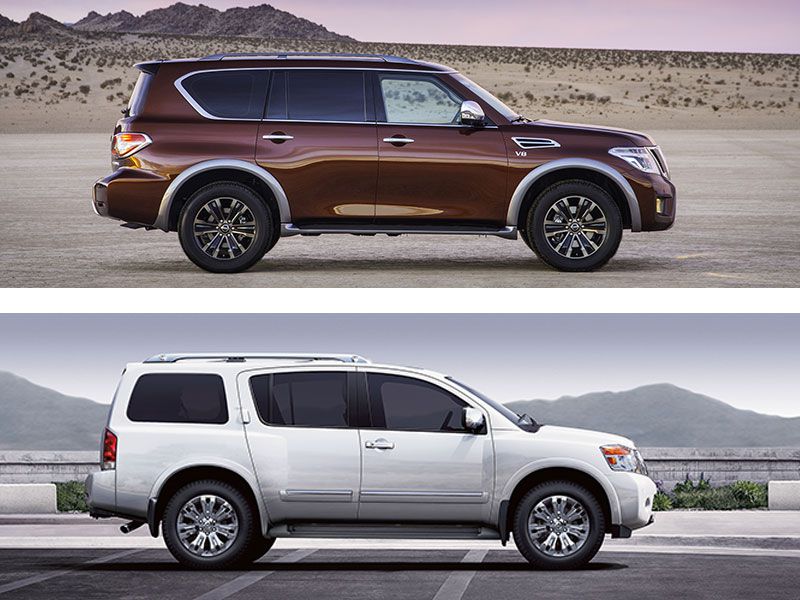
Photo by Nissan
Interior: Lots of space for us, but what about our stuff?
Our first impression of the Armada's interior was positive: We like the sweeping rounded shapes on the dashboard, and the cabin is swathed in high-quality fabrics, plastics, and leathers that felt good under our fingertips. The exception is the wood trim; the pattern reminds us of a Toyota Avalon from the 1990s. The control layout is sensible; there are a lot of buttons for the stereo and air conditioning, and some time will have to be spent on familiarization. But the infotainment system has both a touchscreen and a dial controller, allowing users to pick whichever method of input they prefer.
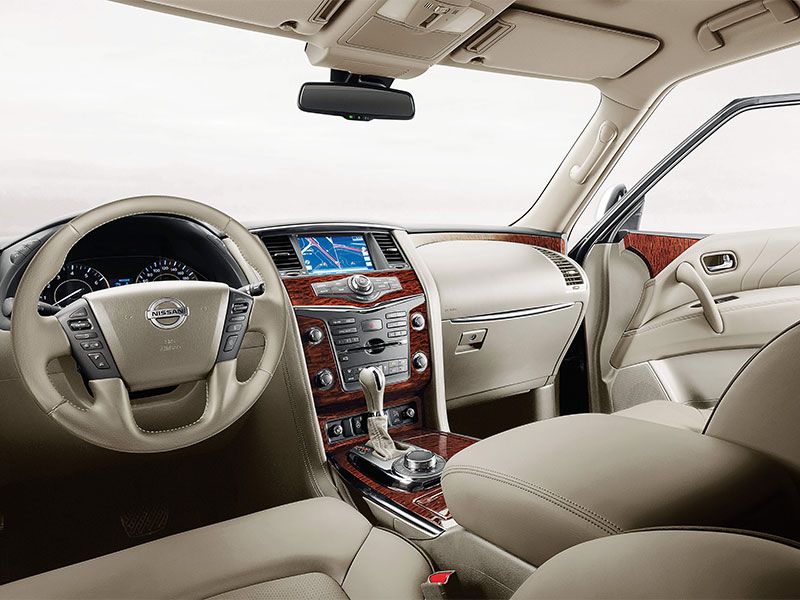
Photo by Nissan
You Can Take it with You... in a Trailer
In cargo space, the new Armada comes up short compared to the old version. There's now just 16.5 cubic feet of space behind the rear seats (down from 20 in the old Armada), though that's still enough for several grocery bags or small suitcases. Folding down the third-row seat opens up 49.9 cubic feet, a decent number (though still less than the outgoing Armada). But the seat doesn't fold perfectly flat; the cargo floor slopes slightly upward. Another problem is the big protruding rear bumper: It makes for a long reach into the cargo bay, especially for shorter folks, and any dirt on the back of the bumper is bound to wind up on their clothes as they reach in. That said, if you're looking to tow a trailer, you're in luck: The new Armada tows 8500 lb. in all versions provided you have the trailer towing package, which is optional on the SV model and standard on SL and Platinum. (The old Armada towed between 6500 and 9000 lb., depending on configuration.) That means the Armada should be able to handle a horse trailer, a medium-size travel trailer, or a decent-sized boat, though we'd avoid lengthy trailers as the Armada's wheelbase may not be long enough to provide the needed stability.
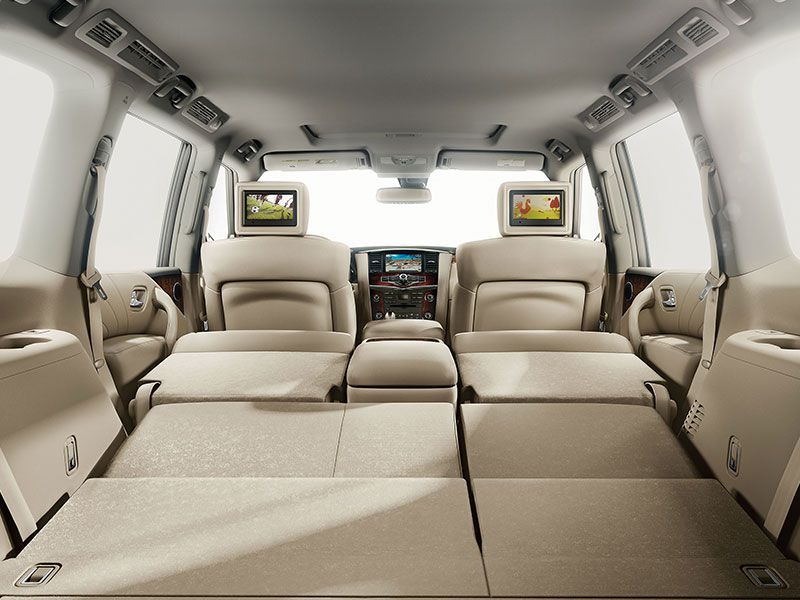
Photo by Nissan
Big Power, Big Grins
Pop open the hood and you'll find the 5.6-liter V8 engine from the Titan pickup truck, tuned for 390 horsepower and 394 lb.-ft. of torque. Those are big numbers; back in the 1960s, few muscle cars had that much power, and those that did certainly didn't run on cheap 87-octane gas like the Armada does. With a curb weight of nearly three tons, the Armada needs all the power it can get, but the big V8 is up to the task: Goose the gas and the Armada leaps ahead like a muscle car, and we found ourselves grinning like idiots every time we floored the pedal (all in the name of thorough journalism, mind you). We expected lousy fuel economy, but the Armada wasn't as thirsty as we feared: Two-wheel-drive models are EPA-rated at 14 MPG city, 19 MPG highway, and 16 MPG combined, while 4x4s are rated 1 MPG lower across the board. We averaged 16.7 MPG during our test drive, and this with repeated testing of the Armada's acceleration (remember, thorough journalism). Some credit goes to the Armada's new 7-speed automatic transmission, which provides a broad range of speeds with lower gears for better acceleration (yeah baby!) and higher gears for efficient highway cruising.
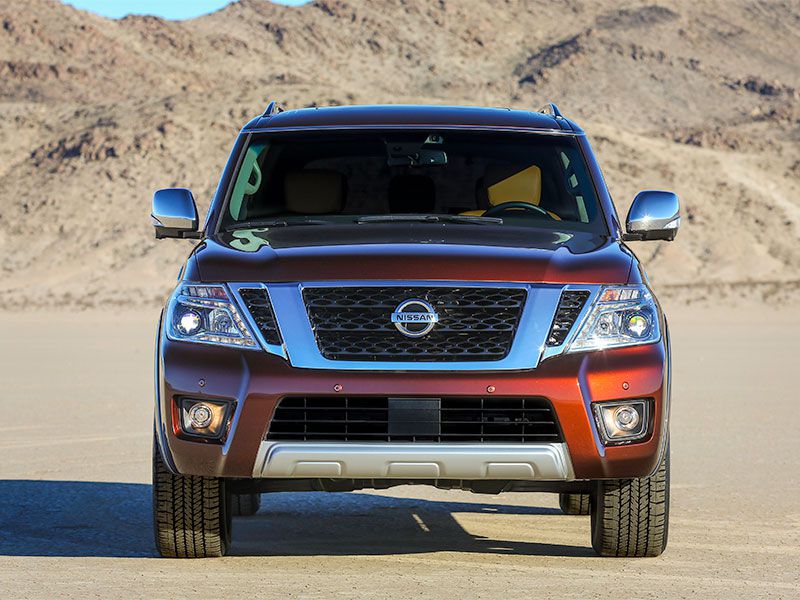
Photo by Nissan
The Joy of Doing Something You Shouldn't
Nissan pointed us toward a curvy road, and we were surprised at how well the Armada made its way through it. The Armada uses traditional hydraulic-assist power steering, as opposed to the more fuel-efficient electric-assist steering used in many SUVs; the upside of hydro is that it generally delivers good road feel. One expects some handling slop in a big SUV, and the Armada certainly doesn't feel as tidy as a sports car, but it turns in eagerly and grips the road strongly, and body lean, while certainly present, isn't overly pronounced.
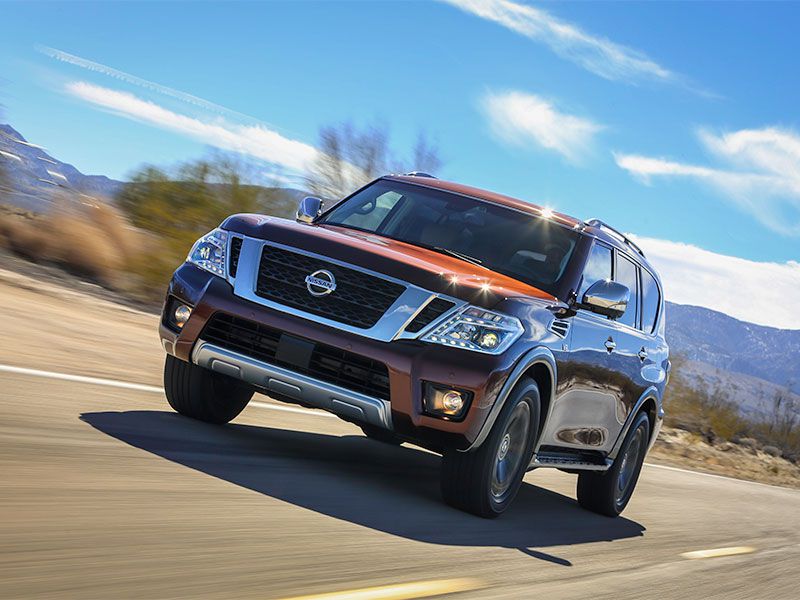
Photo by Nissan
Off-Road: High on Technique, Low on Tech
At the end of that curvy road was an off-road course that Nissan had set up expressly for us to sample the Armada's off-road chops. The Patrol is a well-respected jungle basher, though the most recent version on which the Armada is based is much more civilized than Patrols of the past. We weren't surprised to see that the Patrol can easily claw its way up loose dirt tracks, traverse sideways slopes at frightening angles without tipping over, and drive on three wheels over horrendously uneven terrain.
But we were surprised at the lack of advanced off-road hardware: Though 4x4 Armadas have a 4WD Low mode (which decreases speed and increases pulling power), they don't have hill descent control, which allows a vehicle to safely tip-toe down treacherous descents—all the more surprising as this feature is frequently found on small crossover suvs with barely any off-road ability. And you can forget about advanced features like locking differentials or Toyota's sophisticated Crawl Control system. While we recognize that few SUV owners go off-roading, one would think Nissan would at least offer these features to compete on bragging rights with the Toyota Land Cruiser and Land Rover Discovery. After all, the Patrol has a reputation to uphold!
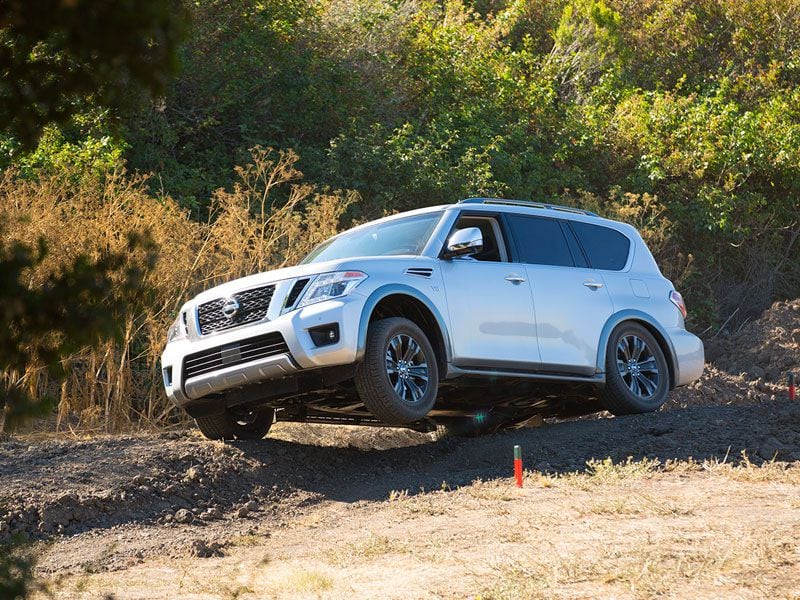
Photo by Nissan
Outfitting Your Armada
Nissan offers the Armada in three models, and even the basic cloth-lined SV comes well equipped with a Bose stereo, navigation, heated power-adjustable seats, and keyless ignition. SL models add leather, rain-sensing wipers, a power-adjustable steering column, and Nissan's Around View Monitor, which provides a bird's eye view that is a boon when parking. An active safety suite is optional on the SL and standard on the top-of-the-line Platinum; it includes a blind-spot warning system, collision protection with automatic braking (that works in forward or reverse), adaptive cruise control, and Nissan's Distance Control Assist, an automatic braking system that works like an invisible co-pilot (unnerving at first, wonderful once you get used to it). The Platinum model is the only one to offer a lane-departure prevention system; it also comes with a rear-seat entertainment system, cooled front seats, and other goodies.
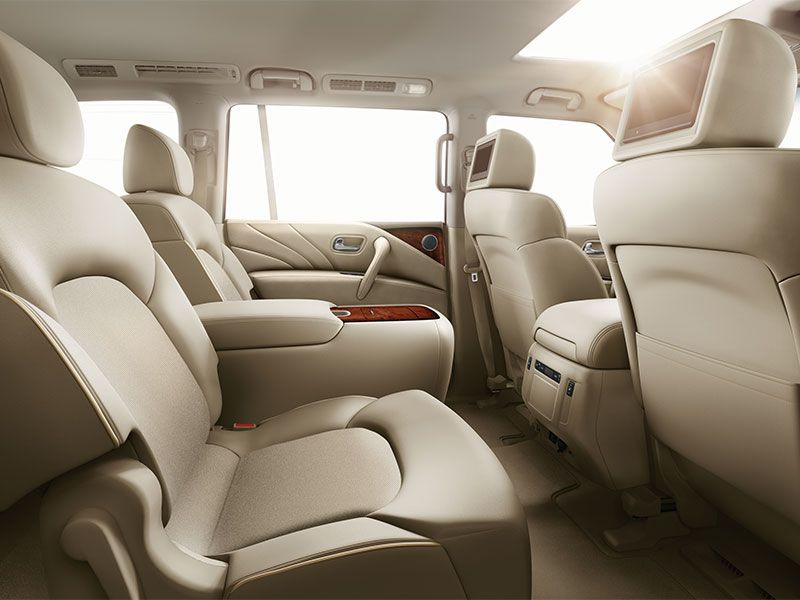
Photo by Nissan
Bottom Line: A Pleasant Surprise
Overall, we were pleasantly surprised by the new 2017 Nissan Armada, mostly in a good way. This large new suv is roomy and well equipped, which we expected, but it's also handsome inside and out, very quick, and good fun to drive, which we weren't expecting at all. We were bothered a bit by the lack of interior storage space and high-end off-road hardware, but neither of those is reason enough to avoid buying this new Nissan. Overall, we think the new Armada is a welcome addition to the full-size SUV market. If you're looking for a big, brawny full-size SUV, we recommend you take the 2017 Nissan Armada for a test drive.
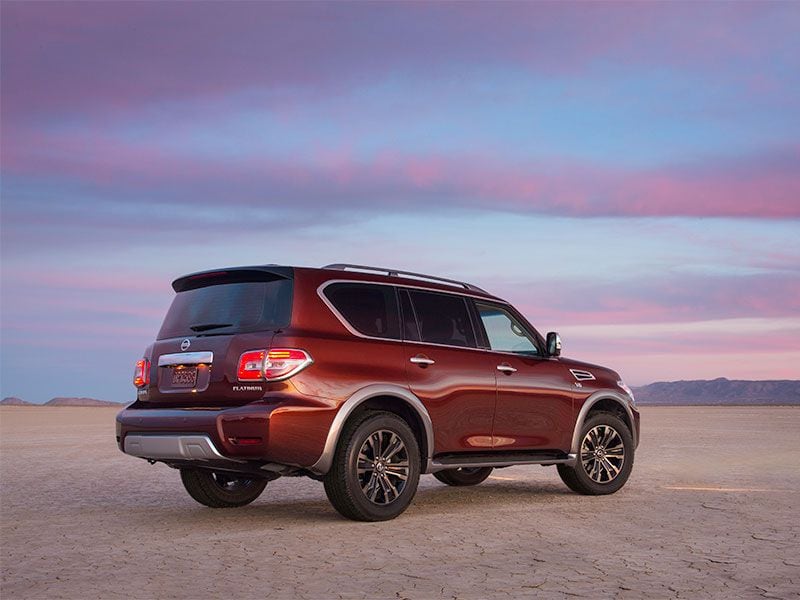
Photo by Nissan